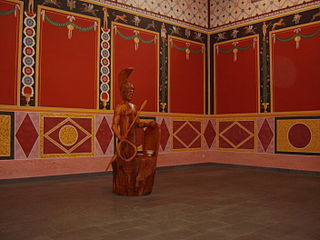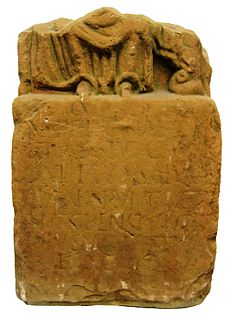Related Research Articles

In Gallo-Roman religion, Rosmerta was a goddess of fertility and abundance, her attributes being those of plenty such as the cornucopia. Rosmerta is attested by statues, and by inscriptions. In Gaul she was often depicted with the Roman god Mercury as her consort, but is sometimes found independently.

In Gallo-Roman religion, Ancamna was a goddess worshipped particularly in the valley of the river Moselle. She was commemorated at Trier and Ripsdorf as the consort of Lenus Mars, and at Möhn as the consort of Mars Smertulitanus. At Trier, altars were set up in honour of Lenus Mars, Ancamna and the genii of various pagi of the Treveri, giving the impression of Lenus Mars and Ancamna as tribal protectors honoured in an officially organized cult. Among the few statuettes left as votive offerings left at the sanctuary of Mars Smertulitanus and Ancamna at Möhn is one of a genius cucullatus like those offered to the Xulsigiae at the Lenus Mars temple complex in Trier.
Artio is a Celtic bear goddess. Evidence of her worship has notably been found at Bern in Switzerland. Her name is derived from the Gaulish word for 'bear', artos.

In Gallo-Roman religion, Arvernus was the tribal god of the Arverni and an epithet of the Gaulish Mercury. Although the name refers to the Arverni, in whose territory Mercury had at important sanctuary at the Puy-de-Dôme in the Massif Central, all of the inscriptions to Mercury Arvernus are found farther away along the Rhenish frontier. The similar name Mercury Arvernorix, ‘king of the Arverni’, is also recorded once. Compare also the title Mercury Dumiatis, found in the territory of the Arverni. The name, like the name of the Arverni and of Auvergne, appears to derive from a Proto-Celtic compound adjective *φara-werno-s ‘in front of alders’.

In Celtic polytheism, Sirona was a goddess worshipped predominantly in East Central Gaul and along the Danubian limes. A healing deity, she was associated with healing springs; her attributes were snakes and eggs. She was sometimes depicted with Apollo Grannus or Apollo Borvo. She was particularly worshipped by the Treveri in the Moselle Valley.
In Gallo-Roman religion, Loucetios was a Gallic god known from the Rhine-Moselle region, where he was invariably identified with the Roman Mars. Scholars have interpreted his name to mean ‘lightning’. Mars Loucetius was worshipped alongside the goddess Nemetona.

In ancient Celtic religion, Maponos or Maponus is a god of youth known mainly in northern Britain but also in Gaul. In Roman Britain, he was equated with Apollo.

In Celtic mythology, Nantosuelta is the goddess of nature, the earth, fire and fertility.

Nemetona, or 'she of the sacred grove', is a Celtic goddess with roots in northeastern Gaul. She is thought to have been the eponymous deity of the Germano-Celtic people known as the Nemetes; evidence of her veneration is found in their former territory along the Middle Rhine as well in the Altbachtal sanctuary in present-day Trier, Germany. She is also attested in Bath, England, where an altar to her was dedicated by a man of the Gallic Treveri people.
In Gallo-Roman religion, Buxenus was an epithet of the Gaulish Mars, known from a single inscription found in Velleron in the Vaucluse.

In Gallo-Roman religion, Sucellus or Sucellos was a deity depicted as carrying a large mallet and also an olla and/or barrel. Originally a Celtic deity, his cult flourished not only among Gallo-Romans, but also to some extent among the neighbouring peoples of Raetia and Britain. He has been associated with agriculture and wine, particularly in the territory of the Aedui.
Cathubodua is the name of a Gaulish goddess inferred from a single inscription at Mieussy in Haute Savoie, eastern France, which actually reads ATHVBODVAE AVG SERVILIA TERENTIA S L M. The text's restitution as Cathubodua depends on the assumptions that an initial C has been lost and that the personal names ATEBODVAE, ATEBODVVS and ATEBODVI in 3 other inscriptions in modern Austria and Slovenia are unrelated.
Satiada was a Celtic goddess worshipped in Roman Britain. She is known from a single, unadorned altar-stone dedicated to her at Chesterholm (Vindolanda). The inscription reads:

Ancasta was a Celtic goddess worshipped in Roman Britain. She is known from a single dedicatory inscription found in the United Kingdom at the Roman settlement of Clausentum. Ancasta may be taken to be a local goddess, possibly associated with the nearby River Itchen.

Gallo-Roman religion is a fusion of the traditional religious practices of the Gauls, who were originally Celtic speakers, and the Roman and Hellenistic religions introduced to the region under Roman Imperial rule. It was the result of selective acculturation.

Cissonius was an ancient Gaulish/Celtic god. After Visucius, Cissonius was the most common name of the Gaulish/Celtic Mercury; around seventeen inscriptions dedicated to him extend from France and Southern Germany into Switzerland.

Visucius was a Gallo-Roman god, usually identified with Mercury. He was worshipped primarily in the east of Gaul, around Trier and on the Rhine; his name is recorded on about ten dedicatory inscriptions. One such inscription has also been found in Bordeaux. Visucius is, along with Gebrinius and Cissonius, among the most common indigenous epithets of the Gaulish Mercury.

Lenus was a Celtic healing god worshipped mainly in eastern Gaul, where he was almost always identified with the Roman god Mars. He was an important god of the Treveri tribe, who had large sanctuaries at medicinal springs at Trier and the Martberg by Pommern in what is now Germany. Two dedications to him are also known from southwestern Britain. Edith Wightman characterizes him as “one of the best examples of a Teutates, or god of the people, equated with Mars—protector of the tribe in battle, but also [...] bestower of health and general good fortune” (p. 211). His sanctuary ‘Am Irminenwingert’ at Trier had a large temple, baths, smaller shrines and a theatre; that on the Martberg also included a large variety of buildings, probably including rooms for health-seeking pilgrims to stay. Despite his associations with healing, Lenus Mars is depicted classically as a warrior with Corinthian helmet in a bronze statuette from the Martberg.

Ritona is a Celtic goddess chiefly venerated in the land of the Treveri in what is now Germany. Her cult is attested at Pachten and at Trier, where she "had a carefully built little temple" in the Altbachtal complex. Ritona's temple was one of several in the Altbachtal to include exedrae and courtyards that may have been used to prepare ritual banquets and/or to place offerings. At Pachten her temple also had a theatre, presumably used for performances of a religious nature.

Intarabus was a Gaulish god in the pantheon of the Treveri and some neighbouring peoples. His name is known from nine inscriptions from a relatively compact area in what are now Belgium, Luxembourg, western Germany and eastern France. He may have been the tutelary deity of one of the three pagi (subdivisions) of the Treveri. In most cases, Intarabus is invoked alone – without any synthesis to a Roman deity, and without accompanying female deities. However, one inscription invokes him as Mars Intarabus, noting that a fanum and simulacrum of this god had been restored at Trier. Meanwhile, another inscription from Mackwiller in Alsace gives Intarabus the epithet Narius. An inscription at Ernzen in Germany has his name as [In]tarabus, while another from Foy-Noville, invokes Entarabus in conjunction with the Genius Ollodagus.
References
- 1 2 Dyfed Lloyd Evans (2005). "Icovellauna: a Gaulish Goddess (Divine Pourer of the Waters) Archived 2006-08-27 at the Wayback Machine " from www.celtnet.org.uk Archived 2006-08-29 at the Wayback Machine , accessed 10 September 2006.
- ↑ CIL XIII, 4294-4298. Of these, only CIL 13: 4294 is complete.
- ↑ CIL XIII, 3644
- ↑ Edith Mary Wightman (1970). Roman Trier and the Treveri. Rupert Hart-Davis, London, p.217.
- ↑ Demarolle (1992), p. 23.
- ↑ Le Sablon › L'histoire › Période gallo-romaine. Includes a line drawing of Icovellauna's sacred well in Metz. Retrieved on 2010-02-27.
- ↑ Demarolle (1992), p. 29.
- ↑ Demarolle (1992), p. 26.
- ↑ Demarolle (1992), p. 27.
- ↑ Miranda Green (1986). The Gods of the Celts. Alan Sutton, Gloucs. ISBN 0-389-20672-5. pp.85, 165.
- ↑ Delamarre (2003), p. 187.
- ↑ Delamarre (2003), p. 310.
- ↑ Nicole Jufer & Thierry Luginbühl (2001). Les dieux gaulois : répertoire des noms de divinités celtiques connus par l'épigraphie, les textes antiques et la toponymie. Editions Errance, Paris. ISBN 2-87772-200-7. p.45; pp.50,70.
- ↑ Scrupulum (2007-03-19). Icovellauna: la bonne eau ou la grande Victoire? (in French) Retrieved on 2010-02-27.
- ↑ Epigraphik-Datenbank Clauss/Slaby. Archived 2010-03-25 at the Wayback Machine Retrieved on 2010-02-27.
Works cited
- Delamarre, Xavier (2003). Dictionnaire de la langue gauloise : Une approche linguistique du vieux-celtique continental (in French) (2nd ed.). Éditions Errance. ISBN 2-87772-237-6.
- Demarolle, Jeanne-Marie (1992). "Les eaux et le sacré dans la Lorraine antique". Dossiers d'Archéologie (in French). 173–177 (174): 22–32. L'eau en Gaule, rites sacrés et thermalisme.

